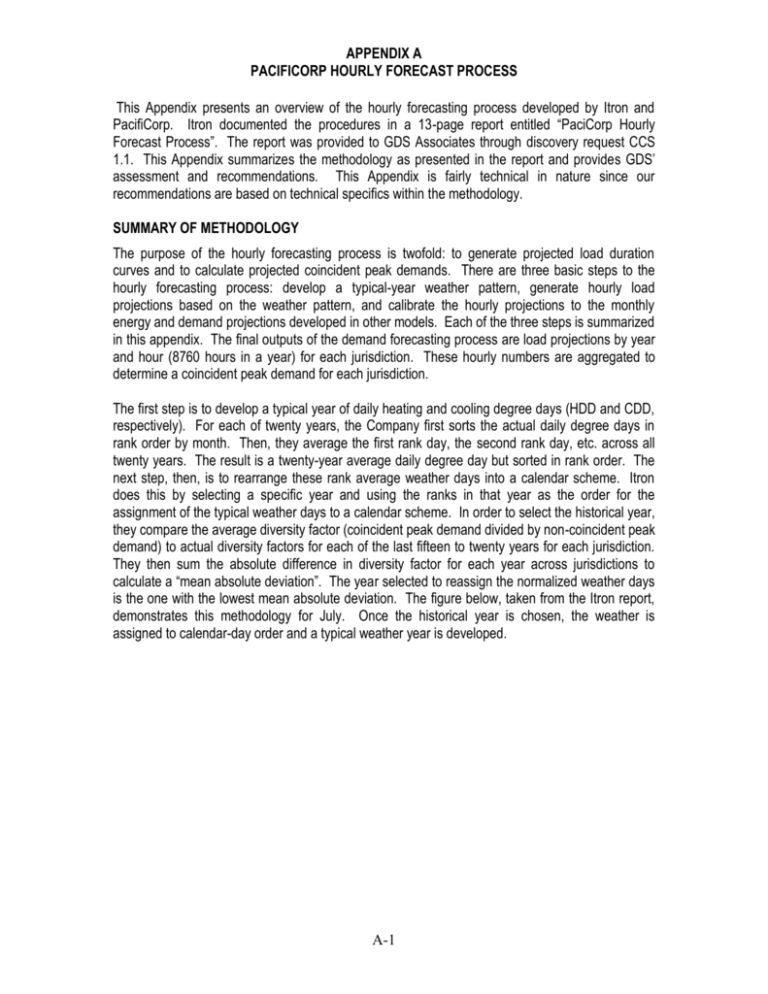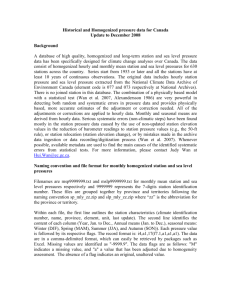Exhibit D
advertisement

APPENDIX A PACIFICORP HOURLY FORECAST PROCESS This Appendix presents an overview of the hourly forecasting process developed by Itron and PacifiCorp. Itron documented the procedures in a 13-page report entitled “PaciCorp Hourly Forecast Process”. The report was provided to GDS Associates through discovery request CCS 1.1. This Appendix summarizes the methodology as presented in the report and provides GDS’ assessment and recommendations. This Appendix is fairly technical in nature since our recommendations are based on technical specifics within the methodology. SUMMARY OF METHODOLOGY The purpose of the hourly forecasting process is twofold: to generate projected load duration curves and to calculate projected coincident peak demands. There are three basic steps to the hourly forecasting process: develop a typical-year weather pattern, generate hourly load projections based on the weather pattern, and calibrate the hourly projections to the monthly energy and demand projections developed in other models. Each of the three steps is summarized in this appendix. The final outputs of the demand forecasting process are load projections by year and hour (8760 hours in a year) for each jurisdiction. These hourly numbers are aggregated to determine a coincident peak demand for each jurisdiction. The first step is to develop a typical year of daily heating and cooling degree days (HDD and CDD, respectively). For each of twenty years, the Company first sorts the actual daily degree days in rank order by month. Then, they average the first rank day, the second rank day, etc. across all twenty years. The result is a twenty-year average daily degree day but sorted in rank order. The next step, then, is to rearrange these rank average weather days into a calendar scheme. Itron does this by selecting a specific year and using the ranks in that year as the order for the assignment of the typical weather days to a calendar scheme. In order to select the historical year, they compare the average diversity factor (coincident peak demand divided by non-coincident peak demand) to actual diversity factors for each of the last fifteen to twenty years for each jurisdiction. They then sum the absolute difference in diversity factor for each year across jurisdictions to calculate a “mean absolute deviation”. The year selected to reassign the normalized weather days is the one with the lowest mean absolute deviation. The figure below, taken from the Itron report, demonstrates this methodology for July. Once the historical year is chosen, the weather is assigned to calendar-day order and a typical weather year is developed. A-1 APPENDIX A PACIFICORP HOURLY FORECAST PROCESS FIGURE 1 Historical Years Select for Assignment Pattern - July Note: Selection based on smallest MAD. MAD = Σ|Deviations from Average| Once the projected hourly weather data is developed, regression models are used to project hourly energy based on those weather patterns. The first model projects energy for the entire day. The daily energy model has calendar, weather, and SAE appliance index data as independent variables. Then, the projected daily energy becomes an input into each of twenty four models that project the energy for each hour of the day. The hourly models also have calendar, weather, and SAE appliance index variables as independent variables. This series of twenty five regression models develop 8760 hourly load projections based on the typical weather produced in the first step of the modeling process. The final step is to calibrate the hourly load projections so (1) the sums total to the monthly energy projections developed from the individual energy sales models and (2) the jurisdictional NCP demand matches the peak forecast from the monthly demand model. The calibration is a two-step process. In the first step, the data is sorted into a load duration curve (LDC), and then the entire curve is shifted up to match the peak demand to the calibration target demand. However, it is highly likely that this resultant LDC will compute some amount of energy that is different from the target energy amount. In order to make the second adjustment, the LDC is “pivoted” with the fixed pivot being the peak demand (see the figure below from the Itron report that demonstrates this effect). Basically, the further away from the peak a particular load falls, the larger an adjustment it will get relative to other hours. Therefore, the minimum load gets the largest adjustment. After this pivot adjustment, the hourly forecast is complete and jurisdictional coincident peak demands can be calculated. A-2 APPENDIX A PACIFICORP HOURLY FORECAST PROCESS FIGURE 2 Calibration of Hourly Curve to Modeled Energy – Pivoting the LDC GDS ASSESSMENT & RECOMMENDATIONS The procedure used by PacifiCorp to generate hourly load projections can be difficult to follow and seems cumbersome. However, generating hourly projections from monthly demand and energy forecasts is not a simple process. Overall, PacifiCorp’s methodology should produce as reasonable results as can be expected when trying to predict hourly loads. However, GDS offers several recommendations regarding the procedure. As stated in the main report, these recommendations would probably not effect CP demand projections enough to impact the IRP planning process. However, it is our opinion that these recommendations improve the theoretical construct of the methodlogy. General Assessment The method of rank averaging to produce a typical weather year is a good one. There are no issues with this procedure. The use of twenty years of historical weather is consistent with the rest of the forecasting process and is a sufficient time-period for normalizing weather. A rolling average as used in the current forecasting process is preferable to a fixed average. The daily energy and hourly energy models used to predict un-calibrated hourly load projections meet or exceed industry standard. These models exhibit strong diagnostics and predictive power over the study period. In general, the calibration methodology is acceptable, with one caveat as listed in the recommendation section below. The step of actually calibrating the hourly energies is an A-3 APPENDIX A PACIFICORP HOURLY FORECAST PROCESS important one and can be a difficult step to accomplish. The Company’s methodology generally meets industry standards. Recommendations There is no clear evidence that using deviation from an average diversity factor is the best methodology for selecting a year for the weather assignment pattern (refer to Figure 1 above). Diversity factors can be impacted by non-weather related variables. Instead, PacifiCorp might consider using the deviation from normal heating and cooling degree days. When selecting the historical year for a weather assignment pattern (refer to Figure 1 above), PacifiCorp should use a weighted average absolute deviation instead of a straight sum (or average). The weights should be based on jurisdictional energy and/or demand, meaning the selection criteria should be weighted more toward years that are typical for Oregon and Utah. GDS concludes the LDC pivot methodology of calibration (assigning a greater amount of adjustment to the minimum loads) can distort the projected load duration curve in a manner that is detrimental to power supply planning. By adjusting minimum loads more, base and intermediate resource requirements may be over- or under-stated due to the calibration method. The Itron documentation does indicate they are aware of this issue. On Page 11 of their documentation, they state that the California adjustment “placed excessive downward pressure on the minimum values”. They took steps to correct for the potential problem. It is important for PacifiCorp to remember to observe the minimum values that result from the calibration to ensure that they are indeed reasonable, especially with respect to the Integrated Resource Plan. GDS recommends a method that spreads the adjustment out more evenly to intermediate and base hours of the load duration curve. A-4





